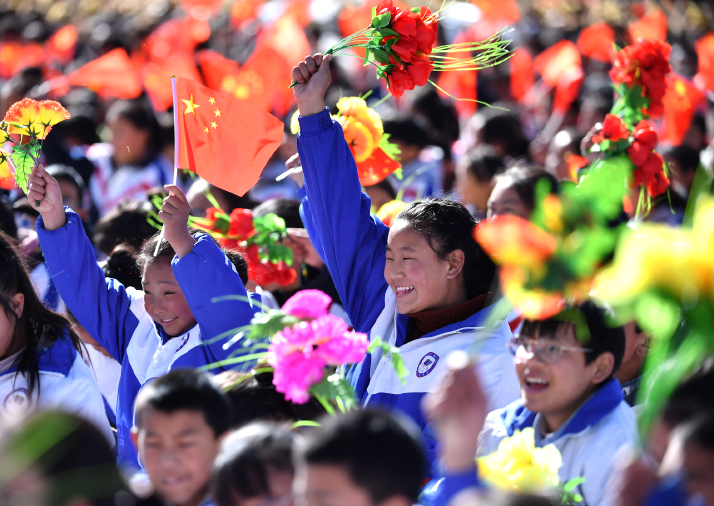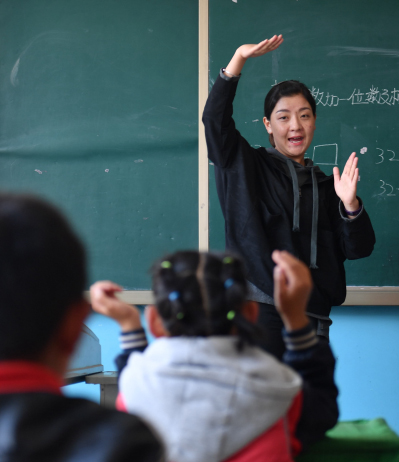| Opinion |
| Better Education | |
| A modern education system has been established in Tibet after the dismantling of feudal serfdom | |
|
|
 Students attend a convention celebrating the 60th anniversary of democratic reform in Tibet at the Potala Palace square in Lhasa, capital of southwest China's Tibet Autonomous Region, on March 28 (XINHUA)
Under the leadership of the Communist Party of China (CPC), Tibet's educational system has grown in scale and quality in the past 60 years. In the past five years, education development in Tibet Autonomous Region has been comprehensive and groundbreaking, a result of efforts of generations of people. Moving forward Before democratic reform, school education in Tibet was at a rudimentary stage. There were only a few small schools and the teaching content was limited. Education was almost completely monopolized by monasteries and aristocrats, with serfs having no access to it. Since the start of reform, a socialist educational system with Tibetan characteristics has been established with a complete set of preschool education, primary and secondary education, higher education, secondary vocational education and adult education, which cover all administrative divisions at all levels. The government has implemented a number of preferential policies to improve education in Tibet. The autonomous region took the lead in China to realize a 15-year free education, with coverage from kindergarten to senior high school. Children in most parts of the country receive nine years of free schooling. For example, boarding schools are encouraged in rural and pasturing areas; food, accommodations and tuition fees are free for some students in middle and primary schools; and student grant and scholarship mechanisms have been established in middle and primary schools in villages and towns. The government also works on ensuring compulsory education coverage and controlling the dropout rate. Last year, the gross enrollment rate at the senior high school level was 82.3 percent. The higher education system has scientific subjects and comprehensive discipline fields that are closely based on Tibet's actual conditions and features. Vocational and adult education, along with cadre and worker training, has seen fast development as well. With sufficient training, students have participated in national vocational skills competitions and achieved satisfactory results. Studies in certain disciplines, such as Tibetology, plateau ecology and traditional Tibetan medicine, are in a leading position nationwide and even worldwide. The Central Government has always made sure to give substantial funds to support education in Tibet. With the increase of government educational appropriations, infrastructure and teaching equipment at schools and educational institutions at all levels have improved. Most school buildings that were made of brick and wood and dilapidated have been renovated into reinforced concrete structures with classrooms, laboratories, dormitories, libraries and reading rooms. With the development of information technology, education via the Internet has also arrived in Tibet, leading to a transformation from traditional education to digital education and signifying the narrowing gap between east and west China in terms of educational concepts and levels. Through trials and exploration, schools at all levels have come up with teaching modes to better adapt to local students' requirements. Courses combine traditional Tibetan cultural heritage, such as Tibetan grammar and orthography, with modern natural and social sciences like politics, history, geography, physics, chemistry, music, art and physical education. While expanding the teaching content, teachers have also tried to improve their teaching methods, which effectively develop the minds of students.  A teacher gives a lesson at a special education school in Lhasa, capital city of southwest China's Tibet Autonomous Region, on May 18, 2018 (XINHUA)
Experience The achievements that Tibet has made in educational work in the past 60 years can be attributed to the following factors: First, the Party committees at all levels have attached great importance to education. An accountability system was established. Primary-level Party organizations have also played an important role in promoting education. By the end of 2018, there were 1,970 primary-level Party organizations in Tibet's education sector, with 35,000 CPC members. Second, the Central Government's policy on ethnic groups is the fundamental prere-quisite for Tibet's educational system. History has shown that the Central Government's policies and measures based on Tibet's actual situation have been successful. At the preliminary stage after the peaceful liberation of Tibet in 1951, teachers from different ethnic groups worked together and adopted a teaching methodology with the Tibetan language as a priority. In 1987, a policy on the application and development of the Tibetan language was introduced by the autonomous region. To implement the policy effectively, schools in Tibet made specific requirements to strengthen the study and use of the Tibetan language, including those related to educational objectives, textbooks, teaching content and teaching programs. Third, educational work in Tibet proceeds from its actual situation, namely its ethnic and endemic features. Tibet is a vast land with a sparse and scattered population. Different areas have unbalanced economic and cultural development. Policies and measures are introduced based on these conditions. For instance, bilingual education, in Tibetan and Mandarin, is adopted in agricultural and pasturing areas and remote mountain areas. Diversified school management forms, such as full-day schooling, half-day schooling and mixed-grade classes, are used under different circumstances. Last but not least, the progress made in Tibet's educational system would not have been possible without the support and help of the rest of the country. Such support is not only shown in the form of goods, materials and capital, but more importantly, in the form of teachers and educational administrative personnel who have brought advanced management experience and ideas on how to run a school. Moreover, as a part of the national policy, schools, colleges and universities in inland areas of China enroll students from Tibet or provide assistance to schools in the autonomous region. Since September 1985, more than 70,000 Tibetan students have been enrolled in middle schools in inland areas. The author is a professor at the Institute of Tibetology Research of Minzu University of China Copyedited by Rebeca Toledo Comments to zanjifang@bjreview.com |
|
||||||||||||||||||||||||||||
|
